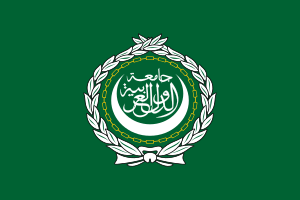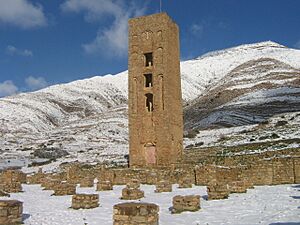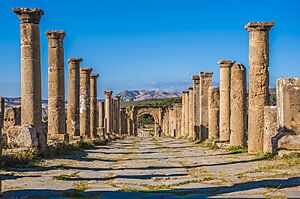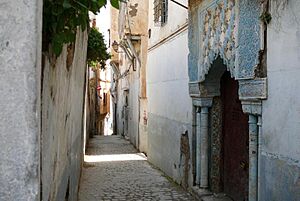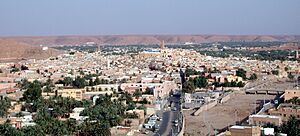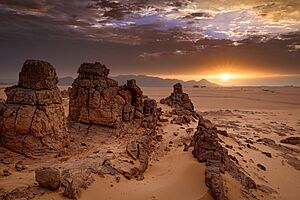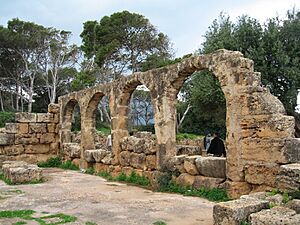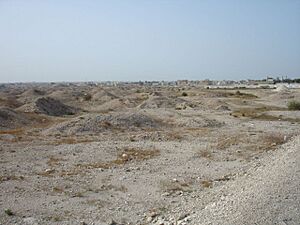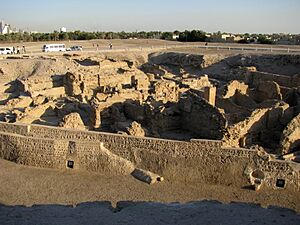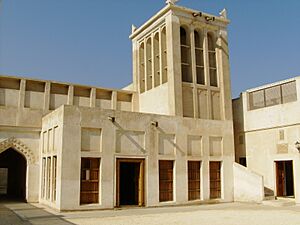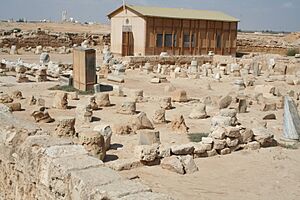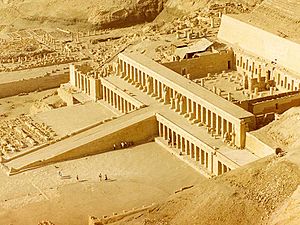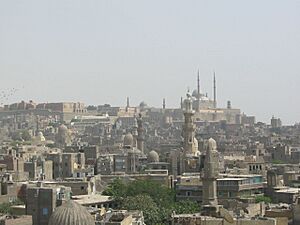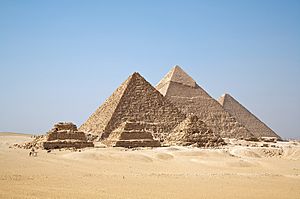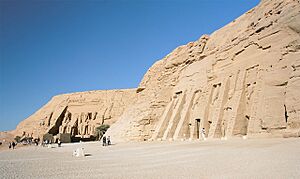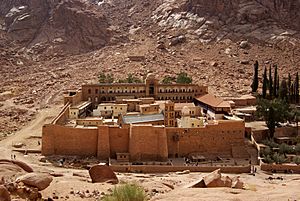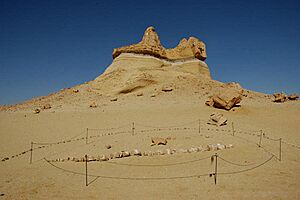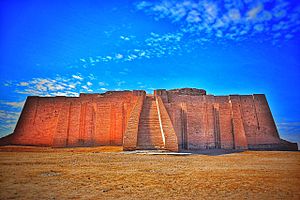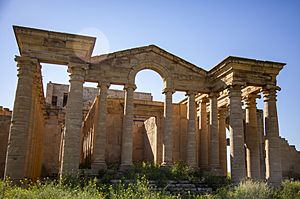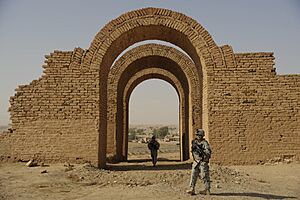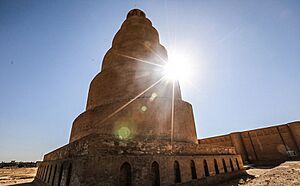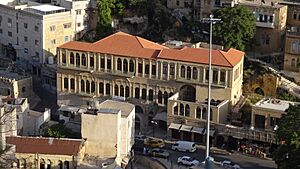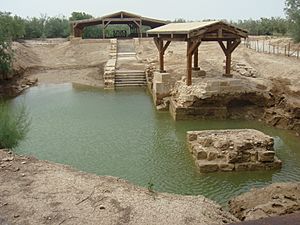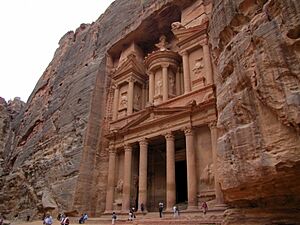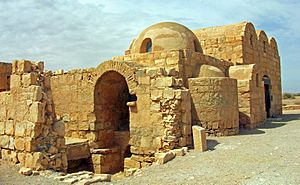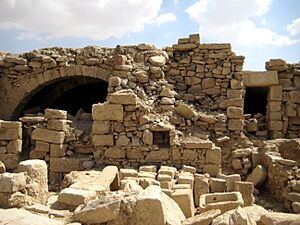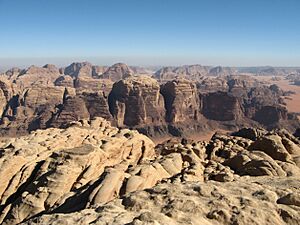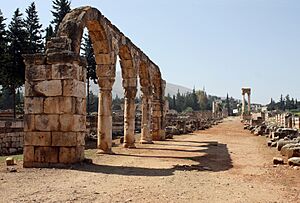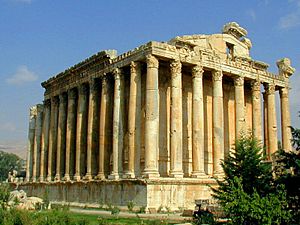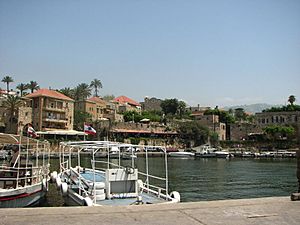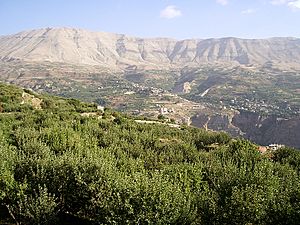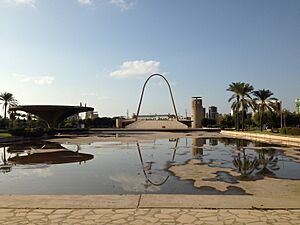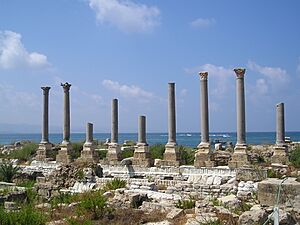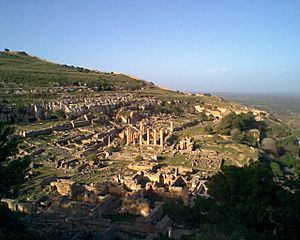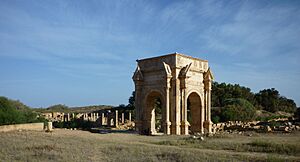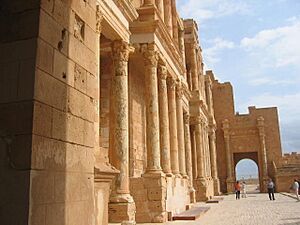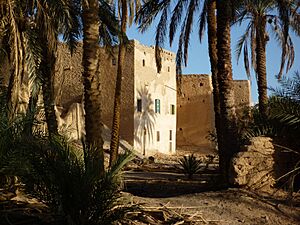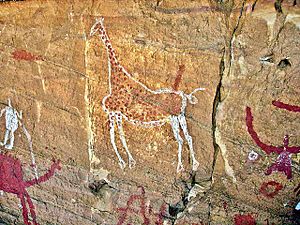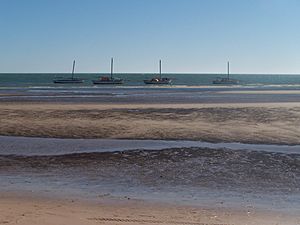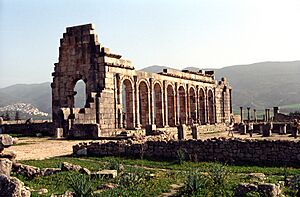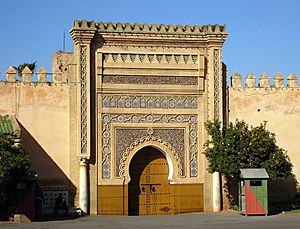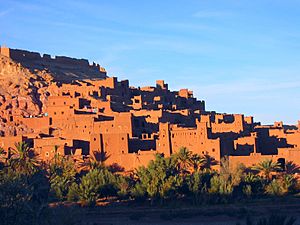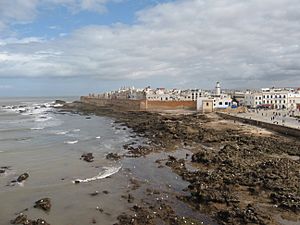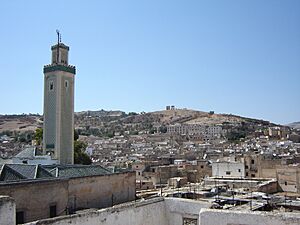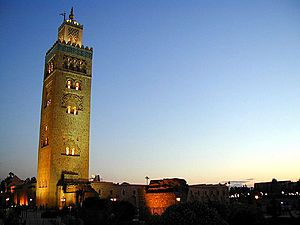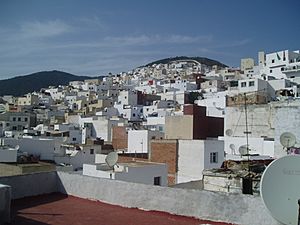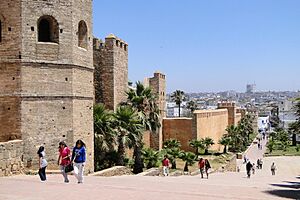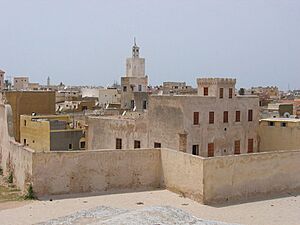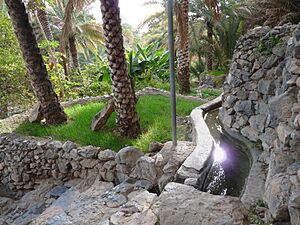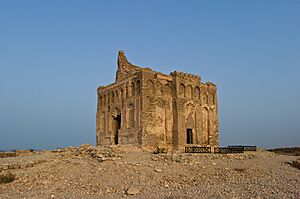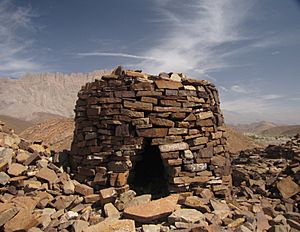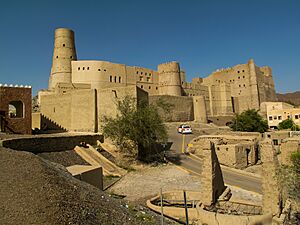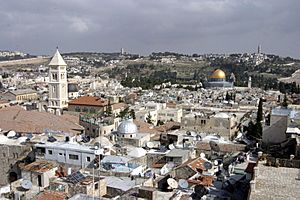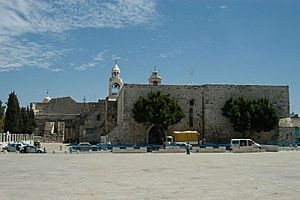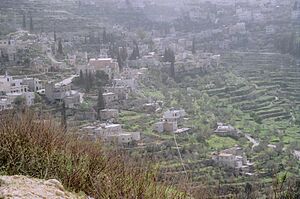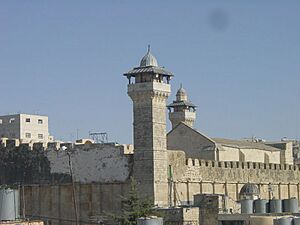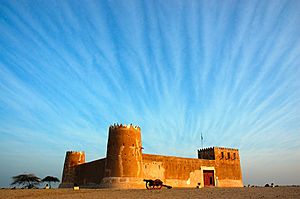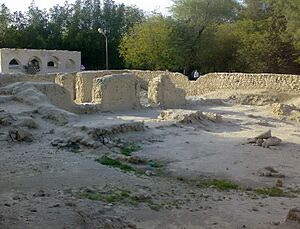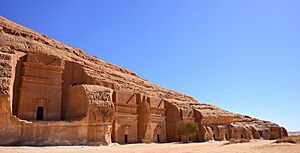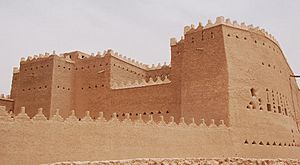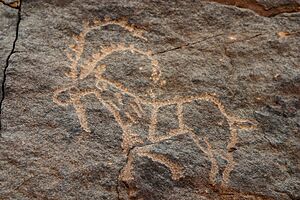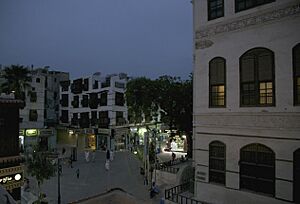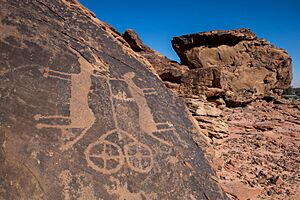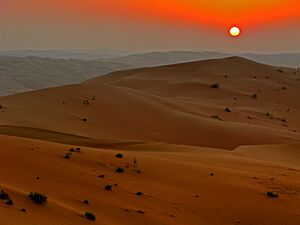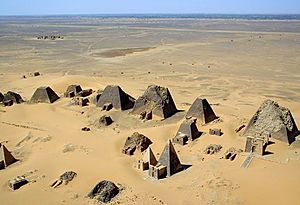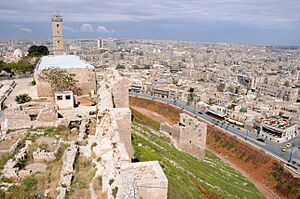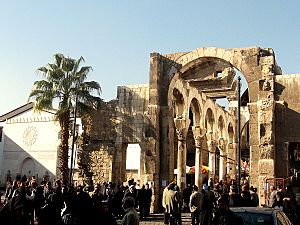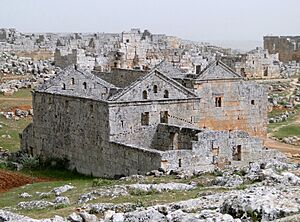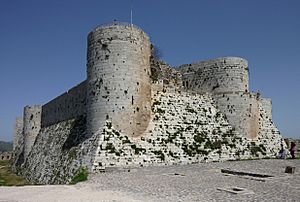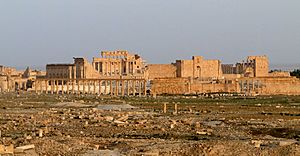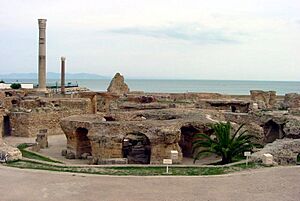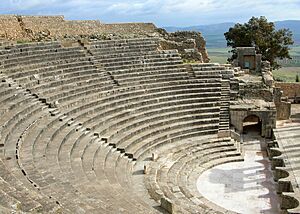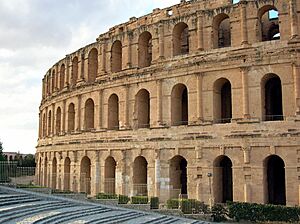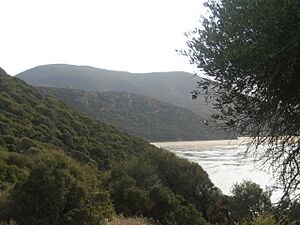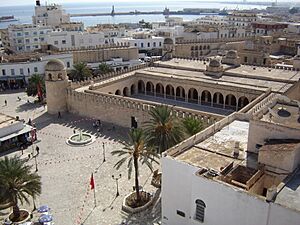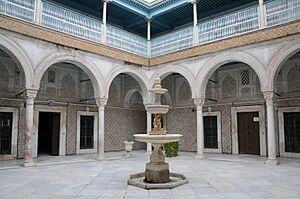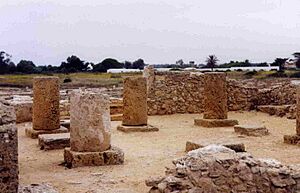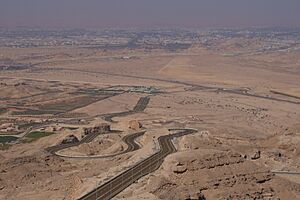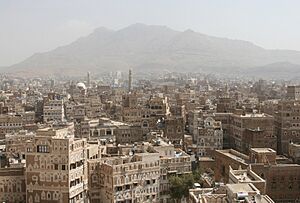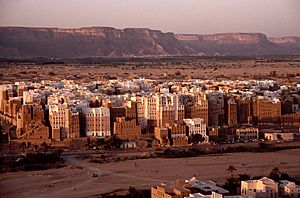List of World Heritage Sites in the Arab states facts for kids
This is a list of amazing places in the Arab states that are recognized as World Heritage Sites. These special places are found across Western Asia and North Africa, from the Atlantic Ocean all the way to the Arabian Sea and the Mediterranean Sea.
UNESCO (which stands for the United Nations Educational, Scientific and Cultural Organization) chooses these sites because they are super important for everyone's history, culture, or nature. Think of them as global treasures!
Some of these sites are cultural, meaning they show off human history, art, or traditions. Others are natural, highlighting incredible landscapes or wildlife. A few are even mixed, having both cultural and natural importance.
Sometimes, a site might be in danger, perhaps from conflict or natural disasters. These sites are marked to show they need extra help and protection.
Contents
Amazing Places in Arab Countries
Algeria
Algeria has several ancient sites that tell stories of its past.
- Qal'at Bani Hammad
This fort was the first capital of the Hammadid rulers, built in 1007. Even though it was taken down in 1152, its ruins still show what a strong Muslim city looked like long ago. It has one of Algeria's biggest mosques. It became a World Heritage Site in 1980.
- Djémila
Djémila was a Roman town built high up in the mountains. It has old forums, temples, and arches, all designed to fit its mountain location. It was added to the list in 1982.
- Casbah of Algiers
The Casbah is a unique old Islamic city right on the Mediterranean Sea coast. It has parts of a citadel, old mosques, and palaces from the Ottoman Empire. It became a World Heritage Site in 1982.
- M'zab
The M'zab Valley is home to five ancient towns called ksour. These towns were built in the 10th century and still show a traditional way of life. It was recognized in 1982.
This huge plateau on the edge of the Sahara Desert is like a giant art gallery! It has over 15,000 cave drawings that show how the climate changed, how animals moved, and how people lived from 6,000 BCE until the first centuries CE. It's also famous for its amazing sandstone rock shapes. This mixed site was added in 1982.
Emperor Trajan built Timgad in 100 CE as a military town. It's a perfect example of how Roman cities were planned, with its main streets, cardo and decumanus, still visible. It became a World Heritage Site in 1982.
Tipaza was first a trading center for the Carthaginians, then became a Roman military base. You can also see signs of early Christian and Byzantine influences here. It was recognized in 1982.
Bahrain
Bahrain has sites that tell stories of ancient civilizations and traditions.
- Dilmun Burial Mounds
These burial mounds on Bahrain Island are from the ancient Dilmun civilization, dating back to 2050 to 1750 BCE. There are over 11,000 mounds, including some two-story "royal" tombs! They became a World Heritage Site in 2019.
- Qal'at al-Bahrain
This fort was once the capital of the Dilmun civilization and has been continuously lived in for thousands of years, since around 2300 BC. A Portuguese fort now stands on top of the ancient ruins. It was added to the list in 2005.
- Bahrain Pearling Trail
This site includes buildings, oyster beds, and a fort, all showing the history of pearl diving in the Persian Gulf. Pearl diving was a huge industry here from the 2nd century until the early 1900s. It became a World Heritage Site in 2012.
Egypt
Egypt is famous for its ancient wonders, and many are World Heritage Sites.
- Abu Mena (In Danger)
These are the ruins of an old Christian holy city, built over the tomb of Saint Menas. It includes a church, baptistery, and other buildings. It was added in 1979, but is currently in danger.
Thebes was once the capital of ancient Egypt. It's home to amazing temples and palaces at Karnak and Luxor, plus the burial grounds of kings and queens in the Valley of the Kings and Valley of the Queens. It shows the peak of Egyptian civilization. It became a World Heritage Site in 1979.
- Islamic Cairo
This is one of the world's oldest Islamic cities, dating back to the 10th century. It's full of beautiful mosques, schools (madrasas), bathhouses (hammams), and fountains. It was added in 1979.
Giza was the capital of Egypt's Old Kingdom. It has many ancient burial monuments, including tombs, temples, and the famous pyramids. It became a World Heritage Site in 1979.
- Nubian Monuments from Abu Simbel to Philae
Along the Nile River, you'll find incredible monuments like the Temple of Ramesses II at Abu Simbel and the Sanctuary of Isis at Philae. These were saved from being flooded when the Aswan Dam was built. It was recognized in 1979.
This is one of the oldest Christian monasteries that is still in use today. It dates back to the 6th century and is near Mount Horeb, where, according to the Bible, Moses received the Ten Commandments. This area is sacred to Christians, Muslims, and Jews. It became a World Heritage Site in 2002.
- Wadi Al-Hitan (Whale Valley)
Located in western Egypt, this valley has amazing fossil remains of ancient whales that are now extinct. These fossils show how whales evolved from land animals to ocean creatures. This natural site was added in 2005.
Iraq
Iraq is home to some of the world's earliest civilizations.
- The Ahwar of Southern Iraq: Refuge of Biodiversity and the Relict Landscape of the Mesopotamian Cities
This site in southern Iraq includes three ancient Sumerian cities: Uruk, Ur, and Eridu. It also has four important wetland areas in the Mesopotamian Marshlands. This mixed site was recognized in 2016.
About 85 kilometers south of Baghdad, you'll find the ruins of Babylon. This city was the capital of the Neo-Babylonian Empire from 626 to 539 BCE. It also includes villages and farms around the ancient city. It became a World Heritage Site in 2019.
- Citadel of Erbil
The Erbil Citadel sits on top of a hill overlooking the city of Erbil. It was once ancient Arbela, an important Assyrian center for politics and religion. It dates back to the Assyrian period. It was added in 2014.
- Hatra (In Danger)
Hatra was a strong, fortified city that belonged to the Parthian Empire. It managed to survive many attacks from the Roman Empire in the 2nd century. Its buildings show a mix of Greek and Roman styles. It became a World Heritage Site in 1985, but is currently in danger.
- Assur (In Danger)
Located on the Tigris River, Assur dates back to the 3rd millennium BCE. It was the first capital and religious center of the Assyrian Empire. After being destroyed by the Babylonians, it was briefly rebuilt. It was recognized in 2003, but is currently in danger.
- Samarra (In Danger)
This Islamic city on the Tigris River was the capital of the Abbasid Caliphate. It has two of the largest mosques and several of the biggest palaces in the Islamic world, showing excellent Abbasid city planning. It became a World Heritage Site in 2007, but is currently in danger.
Jordan
Jordan is home to ancient cities and unique natural landscapes.
- As-Salt – The Place of Tolerance and Urban Hospitality
As-Salt is built on three hills and was a major cultural, business, and financial center on the East Bank of the Jordan River. People from all over the region came here, creating a unique city with yellow limestone buildings that mix European and local styles. It was added in 2021.
- Baptism Site “Bethany Beyond the Jordan” (Al-Maghtas)
This site on the Jordan River is believed to be where Jesus was baptized by John the Baptist. It's a Christian pilgrimage site with remains of Roman and Byzantine churches, chapels, and monasteries. It became a World Heritage Site in 2015.
The Nabataean city of Petra was a huge trading hub connecting Arabia, Egypt, and Syria. It's famous for its buildings carved directly into rock, as well as its clever water systems. It was recognized in 1985.
- Qusayr 'Amra
This desert castle was built in the early 8th century and served as both a fort and a royal palace for the Umayyad rulers. It's known for its amazing wall paintings (frescoes), which are important examples of early Islamic art. It became a World Heritage Site in 1985.
- Um er-Rasas (Kastrom Mefa'a)
Originally a Roman military camp, Um er-Rasas grew into a town by the 5th century, where Christian and Islamic communities lived. The site has ruins of Roman forts, churches with beautiful mosaic floors, and two tall towers. It was added in 2005.
- Wadi Rum
Located in southern Jordan, Wadi Rum has a huge variety of desert shapes, including sandstone valleys, natural arches, and cliffs. It also has lots of rock art and writings that show human life here for over 12,000 years. This mixed site was recognized in 2005.
Lebanon
Lebanon's sites show its rich history as a crossroads of civilizations.
- Anjar
The city of Anjar was built in the early 8th century but was soon abandoned. Its ruins, including walls, towers, palaces, mosques, and baths, are a great example of Umayyad city planning. It became a World Heritage Site in 1984.
Once known as Heliopolis, the Phoenician city of Baalbek has some of the biggest and best-preserved Roman temples, like the Temples of Jupiter, Venus, and Bacchus. It was added in 1984.
Byblos has been continuously inhabited since the Stone Age, making it one of the oldest cities of Phoenician origin. It has seen many rulers, including Persians, Romans, and Ottomans, all of whom influenced its buildings. Byblos also played a big role in spreading the Phoenician alphabet. It was recognized in 1984.
- Ouadi Qadisha (the Holy Valley) and the Forest of the Cedars of God (Horsh Arz el-Rab)
The Qadisha Valley has been a safe place for Christian communities since early Christianity, with many monasteries and hermitages. The Forest of the Cedars of God is one of the last places where the famous Lebanese cedars still grow. It became a World Heritage Site in 1998.
This international fairground in northern Lebanon was designed in 1962 by famous Brazilian architect Oscar Niemeyer. It was a key project for Lebanon's modernization in the 1960s. It was added in 2022.
The ancient Phoenician city of Tyre was a powerful trading city in the eastern Mediterranean. It's said that purple dye was discovered here. Most of the remaining ruins are from Roman times, including baths, an arena, and a hippodrome. It was recognized in 1984.
Libya
Libya's World Heritage Sites showcase its ancient Roman and desert cultures.
- Archaeological Site of Cyrene (In Danger)
Cyrene was a Greek colony that became a Roman capital. It was destroyed by an earthquake in 365 CE. Its thousand-year-old ruins have been famous since the 18th century. It became a World Heritage Site in 1982, but is currently in danger.
- Archaeological Site of Leptis Magna (In Danger)
The Roman city of Leptis Magna was expanded by Emperor Septimius Severus, who was born there. It has impressive public buildings, a harbor, a marketplace, and homes. It was added in 1982, but is currently in danger.
- Archaeological Site of Sabratha (In Danger)
Sabratha started as a Phoenician trading post. It was later rebuilt by the Romans in the 2nd and 3rd centuries. It became a World Heritage Site in 1982, but is currently in danger.
- Old Town of Ghadamès (In Danger)
Located in an oasis, Ghadames is one of the oldest cities in the pre-Sahara region. It has unique traditional houses with different levels for different uses. It was recognized in 1986, but is currently in danger.
- Rock-Art Sites of Tadrart Acacus (In Danger)
The Tadrart Acacus mountains have thousands of cave paintings in different styles. These paintings, from 12,000 BCE to 100 CE, show how the plants and animals changed in the region, and how people lived in the Sahara over time. It became a World Heritage Site in 1985, but is currently in danger.
Mauritania
Mauritania's sites include ancient desert cities and a vital natural park.
- Ancient Ksour of Ouadane, Chinguetti, Tichitt and Oualata
These four settlements were founded in the 11th and 12th centuries to support caravan trade across the Sahara. They grew into important Islamic cultural centers, showing the nomadic way of life in the western Sahara. They were added in 1996.
This park has sand dunes, coastal swamps, small islands, and shallow waters along the Atlantic Ocean. It's a very important place for migrating birds, sea turtles, and dolphins. This natural site was recognized in 1989.
Morocco
Morocco's World Heritage Sites include ancient Roman ruins and vibrant historic cities.
- Volubilis
Volubilis was an important Roman outpost, founded in the 3rd century BCE. It later became the capital of the Idrisid dynasty. Many of its buildings are still well-preserved today. It became a World Heritage Site in 1997.
Meknes was once the capital of the Alaouite dynasty. It was founded in the 11th century and transformed into a city with Spanish-Moorish influences during the 17th and 18th centuries. It was added in 1996.
- Ksar of Ait-Ben-Haddou
The Ksar of Ait-Ben-Haddou is a great example of a traditional fortified village in southern Morocco. It's surrounded by high walls and strong corner towers. It became a World Heritage Site in 1987.
Built in the late 18th century, the fortified port city of Essaouira mixes North African and European building styles. It was a major trading hub between the Sahara and Europe. It was recognized in 2001.
- Medina of Fez
Fez was founded in the 9th century and became very important as the capital of the Marinid dynasty in the 13th and 14th centuries. Its old city and major buildings date from this time. It also has the world's oldest university, Al Quaraouiyine. It was added in 1981.
- Medina of Marrakesh
Marrakesh was founded in the 1070s and remained a key center for politics, economy, and culture for a long time. Important buildings from that period include the Koutoubia Mosque, the kasbah, and the city walls. It was recognized in 1985.
Tétouan has Morocco's most complete medina (old city). It was the main connection between Morocco and Andalusia in the 8th century. The town was rebuilt by refugees from Andalusia, and their influence can be seen in its art and buildings. It became a World Heritage Site in 1997.
Rabat was rebuilt from 1912 to the 1930s, blending old and new features. It has beautiful gardens, the Hassan Mosque, and remains of Moorish and Andalusian settlements from the 17th century. It was added in 2012.
- Portuguese City of Mazagan (El Jadida)
This Portuguese fort, built in the early 16th century, is an example of early Renaissance military design. Morocco took it over in 1769. Surviving parts include a water cistern and a Gothic church. It was recognized in 2004.
Oman
Oman's sites highlight its ancient irrigation systems and trade history.
- Aflaj Irrigation Systems of Oman
These five Aflaj systems are an ancient way of distributing water using gravity, dating back to at least 500 CE. They effectively supply water for farming and daily use. They became a World Heritage Site in 2006.
- Ancient City of Qalhat
Qalhat was an important trading city on the coast of Oman. It was a key port between the 11th and 15th centuries. It was added in 2018.
- Archaeological Sites of Bat, Al-Khutm and Al-Ayn
Located inland, Bat, al-Khutm, and al-Ayn are some of the best-preserved ancient settlements and burial grounds from the 3rd millennium BCE in Eastern Arabia. The burial site of Bat shows the funeral customs of the Early Bronze Age in Oman. They were recognized in 1988.
- Bahla Fort
This fort is part of Bahla, an oasis town that was once the capital of the Nabhani dynasty. This dynasty was powerful in Oman and the Arabian Peninsula during the Late Middle Ages. It became a World Heritage Site in 1987.
- Land of Frankincense
The ancient ports of Khor Rori and Al-Baleed, along with the caravan oasis of Shisr and Wadi Dawkah, were crucial for producing and trading frankincense. Frankincense was a very valuable item in ancient times. It was added in 2000.
Palestine
Palestine has deeply significant religious and cultural sites.
- Old City of Jerusalem and its Walls (In Danger)
Jerusalem is a holy city for three major world religions. It has over 200 historic monuments, including the Dome of the Rock, the Wailing Wall, and the Church of the Holy Sepulchre. It was recognized in 1981, but is currently in danger.
This site is traditionally believed to be where Jesus was born. The church, built in the 4th century and rebuilt in the 6th century, is very important to both Christians and Muslims. It became a World Heritage Site in 2012, but is currently in danger.
- Palestine: Land of Olives and Vines – Cultural Landscape of Southern Jerusalem, Battir (In Danger)
The hilly landscape of Battir has stone terraces used for growing vegetables, grapes, and olives. These farms are supported by a traditional irrigation system. It was added in 2014, but is currently in danger.
- Hebron/Al-Khalil Old Town (In Danger)
The most important part of Hebron is the Al-Ibrahimi Mosque/The Tomb of the Patriarchs. This building was constructed in the 1st century CE to protect the tombs of Abraham and his family. It was recognized in 2017, but is currently in danger.
Qatar
Qatar's site tells the story of its pearling and trading past.
- Al Zubarah
The coastal town of Al Zubarah was a major center for pearl diving and trade in the Persian Gulf in the late 1700s and early 1800s. It was destroyed in 1811 and later abandoned. The desert sand has helped preserve the remains of its palaces, mosques, and forts. It became a World Heritage Site in 2013.
Saudi Arabia
Saudi Arabia's sites include ancient cities, rock art, and unique natural areas.
- Al-Ahsa Oasis, an Evolving Cultural Landscape
Al-Ahsa is a large oasis with a rich history of human settlement and agriculture. It shows how people have lived and farmed in a desert environment for a long time. It was added in 2018.
- Al-Hijr Archaeological Site (Madâin Sâlih)
Formerly known as Hegra, this site is the largest settlement of the Nabataean Kingdom after Petra. It has many well-preserved rock-cut tombs and monuments from the 1st century BCE. It became a World Heritage Site in 2008.
- At-Turaif District in ad-Dir'iyah
Founded in the 15th century, the Turaif District of Dir'iyah was the first capital of the Saudi dynasty. It became very important politically and religiously in the 18th and early 19th centuries. It was recognized in 2008.
- Bir Hima Rock Petroglyphs and Inscriptions
The Ḥimā Cultural Area has many rock art images that show hunting scenes, animals, plants, and the daily lives of people from 7,000 years ago. It was added in 2021.
- Historic Jeddah, the Gate to Makkah
Located on the Red Sea coast, Jeddah became a major trading center in the 7th century. It has long been the main entry point for pilgrims traveling to Mecca. It became a World Heritage Site in 2014.
- Rock Art in the Ha'il Region
The sites of Jabel Umm Sinman and Jabal al-Manjor and Raat have a large number of rock carvings and writings that cover 10,000 years of human history. It was recognized in 2015.
- ‘Uruq Bani Mu’arid
This area covers the western part of the largest sand desert on Earth, known as Ar Rub' al-KhaIi. It protects one of the most amazing desert landscapes on our planet. This natural site was added in 2023.
Sudan
Sudan's sites reveal ancient kingdoms and rich marine life.
Meroe was the center of the Kingdom of Kush, a powerful force from the 8th century BCE to the 4th century CE. It has pyramids, temples, and homes, among other ancient remains. It became a World Heritage Site in 2011.
- Gebel Barkal and the Napatan Region
The archaeological sites of Gebel Barkal, Kurru, Nuri, Sanam, and Zuma in the Nile Valley show the Napatan and Meroitic civilizations. They include pyramids, tombs, temples, and palaces. They were recognized in 2003.
- Sanganeb Marine National Park and Dungonab Bay – Mukawar Island Marine National Park
Located in the central Red Sea, these parks have diverse coral reefs, mangroves, seagrass beds, and beaches. They are home to many seabirds, marine mammals, fish, sharks, turtles, manta rays, and dugongs. This natural site was added in 2016.
Syria
Syria's sites are ancient cities and castles, though some are currently in danger.
- Ancient City of Aleppo (In Danger)
Aleppo was a crossroads for many trade routes and was ruled by Romans, Ayyubids, Mameluks, and Ottomans, among others. Each left their mark on its buildings, creating a diverse city. Important structures include the Citadel, the Great Mosque, and the Madrasa Halawiye. It was recognized in 1986, but is currently in danger.
- Ancient City of Bosra (In Danger)
Bosra was first a Nabataean settlement, then conquered by the Romans in the 2nd century CE and made a capital. It came under Islamic rule in the 7th century. Remains include a theatre, a basilica, a cathedral, a mosque, and a madrasa. It was added in 1980, but is currently in danger.
- Ancient City of Damascus (In Danger)
Damascus is one of the oldest continuously inhabited cities in the world, established in the 3rd millennium BCE. As the capital of the Umayyads, it greatly influenced the Arab world. Its Great Mosque is one of the largest and oldest places of continuous prayer since Islam began. It was recognized in 1979, but is currently in danger.
- Ancient Villages of Northern Syria (Dead Cities) (In Danger)
This site includes about 40 villages that date from the 1st to 7th centuries and were abandoned later. They give us a look into rural life during late Roman and Byzantine times. They were added in 2011, but are currently in danger.
- Crac des Chevaliers and Qal'at Salah El-Din (In Danger)
These two castles are considered some of the best examples of castles from the Crusader period. They show how fortifications evolved and how different ideas about defense were shared. They became a World Heritage Site in 2006, but are currently in danger.
- Site of Palmyra (In Danger)
Palmyra came under Roman rule in the 1st century CE and became one of the most important cultural centers of the ancient world. Its extensive ruins include the Great Colonnade, the Temple of Bel, and the Roman Theatre. It was recognized in 1980, but is currently in danger.
Tunisia
Tunisia's sites include ancient cities, Roman amphitheatres, and natural parks.
- Archaeological Site of Carthage
Founded in the 9th century BCE, Carthage grew into a huge trading empire across the Mediterranean. It was destroyed by the Romans in the Punic Wars but was later rebuilt. It became a World Heritage Site in 1979.
- Dougga/Thugga
This site has the ruins of Dougga, which was once the capital of a Libyan–Punic state. It thrived under the Romans and Byzantines but declined during the Islamic period. It was added in 1997.
- Amphitheatre of El Jem
Built in the 3rd century, this is North Africa's largest amphitheater and the biggest one outside of Italy. It could hold 35,000 spectators and is a fantastic example of Roman architecture. It was recognized in 1979.
- Ichkeul National Park
Ichkeul Lake and its surrounding wetlands are a major stop for hundreds of thousands of migrating birds, including ducks, geese, storks, and pink flamingos. This natural site was added in 1980.
- Kairouan
Founded in 670, Kairouan was the former capital of Ifriqiya and became very important in the 9th century. Its heritage includes the Mosque of Uqba and the Mosque of the Three Gates. It became a World Heritage Site in 1988.
- Medina of Sousse
A great example of an early Islamic town, Sousse was an important trading and military port in the 9th century. It was recognized in 1988.
- Medina of Tunis
The Medina of Tunis has about 700 monuments, including palaces, mosques, and schools. These show Tunis's golden age from the 12th to the 16th century. It was added in 1979.
- Punic Town of Kerkuane and its Necropolis
Abandoned in 250 BCE during the First Punic War and never rebuilt, Kerkuane is the only surviving example of a Phoenicio–Punic settlement. It was recognized in 1985.
United Arab Emirates
The UAE's site shows ancient settlements and irrigation.
Located in a desert region, Al Ain has been inhabited since the Neolithic period. It has stone tombs from the 3rd millennium BCE, wells, and one of the oldest examples of the aflaj irrigation system. It became a World Heritage Site in 2011.
Yemen
Yemen's sites include historic cities and a unique natural island.
- Historic Town of Zabid (In Danger)
Zabid was the capital of Yemen from the 13th to the 15th century. Its Islamic university played a big role in spreading Islamic knowledge. It was recognized in 1993, but is currently in danger.
- Old City of Sana'a (In Danger)
Located in a mountain valley, Sana'a has been continuously inhabited for over 2,500 years. It became a center for the spread of Islam in the 7th and 8th centuries. The city is known for its unique mud-brick tower-houses, plus many old mosques and bathhouses. It was added in 1986, but is currently in danger.
- Old Walled City of Shibam (In Danger)
The 16th-century walled city of Shibam is one of the oldest and best examples of vertical city planning. Its distinct mud-brick tower houses have earned it the nickname "the Manhattan of the desert." It was recognized in 1982, but is currently in danger.
Even though it's part of the African landmass, the Socotra Archipelago is managed by Yemen. It's famous for its amazing biodiversity and unique plants and animals, many of which are found nowhere else on Earth. It also supports a wide range of birds and marine life. This natural site was added in 2008.
See also
 In Spanish: Anexo:Patrimonio de la Humanidad en Estados árabes para niños
In Spanish: Anexo:Patrimonio de la Humanidad en Estados árabes para niños
- List of World Heritage Sites in Africa
- List of World Heritage Sites in Western Asia
- Destruction of cultural heritage by ISIL


